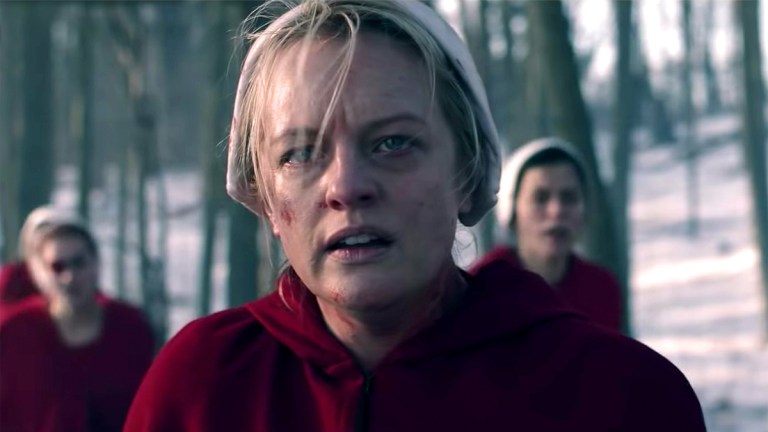The Handmaid’s Tale Season 4 Episode 1 Review: Has the Story Outgrown the Limits of June’s Character?
Now that June’s a symbol of revolution, maybe the most compelling stories The Handmaid’s Tale has to tell aren’t about her. Spoilers.

This The Handmaid’s Tale review contains spoilers.
“Are you ready?” they asked June, holding a red hot cauteriser over her bleeding gunshot wound. “No,” she said, but they jabbed her anyway. Hard relate. The Handmaid’s Tale has been away for almost two years, and now it’s back, are we ready for the pain? Of course not, but it’s happening.
In any other show, episode one’s pain would have been been extreme. Esther’s story of a bloody act of revenge inspired by child sexual abuse would have been a rare depth plumbed, the culmination of a whole-series crime mystery, or a long-held simmering character secret. Here? It’s just another day in Gilead. Mrs Keyes (played with remarkable self-possession by 14-year-old actor McKenna Grace), is one awful story among thousands.
Specifically, she’s the story June fears will become Hannah’s in the near future. In her numbed, feverish state, June conflated the two girls and called Esther by her daughter’s nickname in that final “I love you too, Banana,” scene.
Esther isn’t June’s only adoptive daughter, our lead is also the protector of Janine and all the other former Handmaids. Despite barely being able to walk, June insisted on approaching the safe house alone, signalling to them when it was safe to follow. When they were dancing like teenagers in the barn, she only looked on. She’s no longer one of them, but their leader – a resistance hero in command of an underground revolt. More than that, she’s become a celebrity in this world – a figurehead for everybody who wants to see Gilead burn. She’s Che Guevara, a symbol of revolution. If Gilead’s rebels could put her face on t-shirts, they would.
A potential problem for season four is that symbols don’t make compelling characters. The transformation from person to icon can be fascinating, but once a character’s up on that pedestal, giving out rousing speeches and making the hard decisions, they’ve generally reached their climax. However supreme Elisabeth Moss remains in this role, there’s a sense that we may already have seen everything that June Osborne the character has to offer. How many times now have we watched June – as she did in this episode – suffer, collapse, and then rise up with a renewed sense of fight? Half a dozen? More? At some stage, a repeating pattern begins to lose impact.
That may not be fatal, because The Handmaid’s Tale is no longer June’s story. Not really. Thanks to her, it’s now the story of Gilead’s fall, starting with the loss of the children she saved. A highlight of this season opener was watching the Waterfords receive the news that not only were there now 86 new Baby Nicholes in Canada, but that June was behind it. The looks on their faces. That whole scene crackled with hostility, making the prospect of any return visit to those two tantalising. Fingers crossed their trial isn’t delayed much further.
Commander Lawrence’s trial came and went, without him, or us, and with a rug pull ending. All episode, he and the viewer had been led to believe that Lawrence was heading the way of Janine’s pig Mr Darcy and facing execution for his role in the mass break-out that happened under his nose. Not so. Nick’s retcon ascent to power must have shot him to such heights that he was able to argue the case for keeping Lawrence around for the war ahead. Given the choice between Bradley Whitford and no Bradley Whitford of course, any sane TV viewer would choose the former, even if his character’s survival stretches credulity in a world where arms are amputated and necks broken for much less.
The episode denied us a glimpse at this season’s more compelling storyline – the fates of those children in the 19 days they’ve been on Canadian soil. While June was staggering around that farmstead getting her murderous groove back, it was hard not to let attention drift to the reunions and culture shock going on off-screen. How was Canada reacting to the bombshell arrival of those kids? Were Rita and Luke bonding? Did the sight of them bring back the Gilead trauma for Moira and Emily? Our investment in the stories of the ensemble is a credit to The Handmaid’s Tale’s thoughtful expansion of Margaret Atwood’s world.
It’s not just the production team who’ve expanded that world of course. Since season three aired, Atwood published Booker Prize-winning sequel The Testaments, set 15 years after the end of her original novel. For TV viewers who’ve read it, the book offers an endpoint for the series that will be fascinating to see reached.
The opener’s other highlight came courtesy of the indomitable Ann Dowd. Aunt Lydia appeared in front of the Sons of Jacob bearing signs of torture after 19 days of interrogation by the Eyes. The experience hadn’t softened her permanent fury, but it did appear to have pointed it in a new direction. She hissed with disdain for the Sons, her required humility in their presence accompanied by what seemed like visceral contempt. Her parting line about them doing their jobs and bringing June to her, was almost delivered as a threat. What an actor, and what potential in her trajectory ahead.
The Handmaid’s Tale season four is streaming now on Hulu in the US. Season four is airing weekly on Sundays at 9pm on Channel 4 in the UK.

